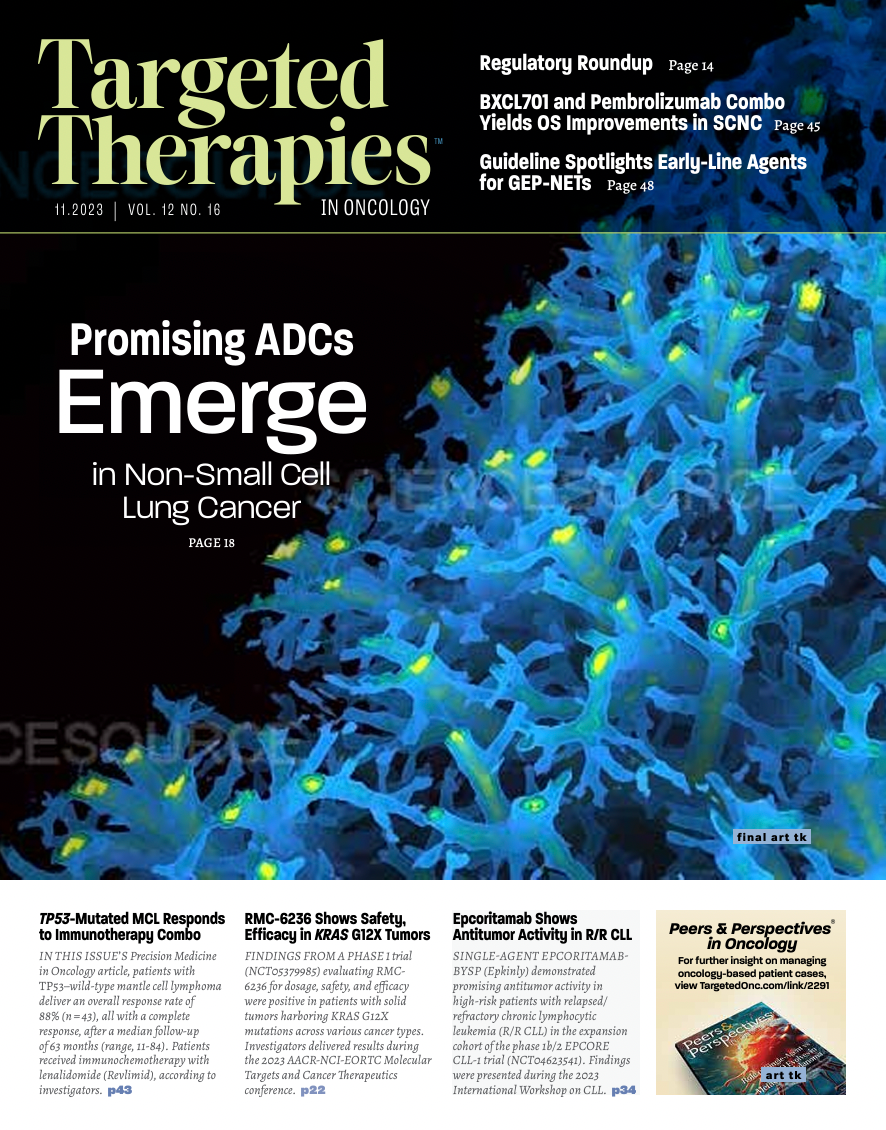Guideline Spotlights Early-Line Agents for GEP-NETs
New guidelines for gastroenteropancreatic neuroendocrine tumors were issued by the American Society of Clinical Oncology and geared toward community oncologists who often encounter these rare and complex cases infrequently.
Jaydira Del Rivero, MD
Associate Research Physician
Physician Scientist
Developmental Therapeutics Branch
Principal Investigator
Natural History Study for Neuroendocrine Neoplasm and Adrenocortical Cancer
National Cancer Institute Center for Cancer Research
Bethesda, MD

New guidelines for metastatic well-differentiated gastroenteropancreatic neuroendocrine tumors (GEP-NETs) of grades 1 to 3 focus on somatostatin analogs such as octreotide (Sandostatin) and lanreotide (Somatuline) in the first line and peptide receptor radionuclide therapy in the second line.
The guidelines were issued by the American Society of Clinical Oncology as its first official recommendation for these tumor types and are geared toward community oncologists who often encounter these rare and complex cases infrequently. They are categorized by lines of therapy, grade, and location of the tumor.1,2
In the first line, for patients with slow- growing or low-volume disease with no symptoms, observation is another viable option, according to the recommendations.
For both pancreatic and gastrointestinal NETs, peptide receptor radionuclide therapy should be considered.1 The guidelines continue with alternative routes of therapy depending on the patient’s individual progression and are contrasted with the National Comprehensive Cancer Network guidelines, which recommend resection as primary management for most localized pancreatic NETs.3
“We’ve made a conscious intention to think through questions posed to us at our high-volume centers by community oncologists, who are seeing these patients in the community with potentially limited experience or limited resources in regard to multidisciplinary care. We set out to integrate as much as we could so that clinicians using the guidelines outside of the high-volume centers would hopefully have their questions answered in published form,” Kimberly Perez, MD, told Targeted Therapies in Oncology in an interview. Perez is assistant professor of medicine at Harvard Medical School, clinical investigator at Hale Family Center for Pancreatic Cancer Research, and medical oncologist at Dana-Farber Cancer Institute in Boston, Massachusetts.
Kimberly Perez, MD
Assistant Professor of Medicine
Harvard Medical School Clinical
Investigator
Hale Family Center for Pancreatic Cancer Research
Senior Physician
Dana-Farber Cancer Institute
Boston, MA

GEP-NETs comprise a diverse group of tumors primarily affecting the pancreas, gastrointestinal tract, and related organs and present an added challenge due to their rarity and complex clinical presentation. Tailoring treatment depends on various factors, including tumor grade, location, hormone status, and patient symptoms.2 Because these tumors often present at advanced stages, the focus is on metastatic and advanced GEP-NETs.4
Eight pivotal trials form the bases for the guideline, including the NETTER-1 trial (NCT01578239),which evaluated lutetium Lu 177 dotatate (Lutathera), a radioactive-based therapy. These results have encouraged further research into innovative systemic radiotherapies and combination approaches, providing more options for patients.2 In the trial, 229 patients were randomly assigned to receive either a 7.4-GBq dose every 8 weeks of lutetium Lu 177 dotatate or a 60-mg dose every 4 weeks of octreotide acetate (Sandostatin LAR Depot) alone.4
The lutetium Lu 177 dotatate treatment group exhibited an estimated rate of progression-free survival at month 20 of 65.2% (95% CI; 50.0%-76.8%) compared with 10.8% (95% CI; 3.5%-23.0%) in the control group. The response rate was 18% in the lutetium Lu 177 dotatate group vs 3% in the control group (P < .001), and the interim analysis of overall survival recorded 14 deaths in the lutetium Lu 177 dotatate group as opposed to 26 in the control group (P = .004). Patients in the lutetium Lu 177 dotatate group experienced grade 3 or 4 neutropenia, thrombocytopenia, and lymphopenia at rates of 1%, 2%, and 9%, respectively.4 There were no reported instances of renal toxic effects in either group within the observed time frame.
Although the guideline recommendations address various aspects regarding treatment selection, the need for further research is ongoing. There has been great development with investigational treatments, immunotherapies, and biomarkers, but the challenge remains of knowing how best to use them in terms of sequencing. There’s also an ongoing effort to develop recommendations on managing specific symptoms of GEP-NETs.
“Whenever we make treatment recommendations, there are various factors that we need to keep in mind such as different characteristics of the tumor, and whether their hormone status is functional or not, and how we can address that. We’re also working on follow-up guidelines of symptomatic management for neuroendocrine tumors and how we manage the hormone excess related to neuroendocrine tumors and other symptoms as well,” Jaydira Del Rivero, MD, told Targeted Therapies in Oncology in an interview. Del Rivero is a physician scientist at the Developmental Therapeutics Branch, principal investigator of the Natural History Study for Neuroendocrine Neoplasm and Adrenocortical Cancer, and associate research physician at the National Cancer Institute Center for Cancer Research in Bethesda, Maryland.
Recent reports of ongoing studies also play a part in further developing treatment recommendations, such as the CABINET study (NCT03375320), which is evaluating cabozantinib (Cabometyx) vs placebo in patients with advanced pancreatic neuroendocrine and carcinoid tumors.5 “I’m very excited, because I think this will add another option for patients with gastroenteropancreatic neuroendocrine tumors, especially for small bowel, neuroendocrine tumors where we need more options. The interim data from this phase 3 study significantly improves progression-free survival,” Del Rivero explained.
Despite the evolving landscape, this guideline helps by empowering community oncologists to make informed treatment decisions for patients facing these rare and challenging tumors. By providing a standardized approach, the guideline recommendations aim to enhance patient outcomes and quality of life, ensuring that individuals receive the most effective care available.
REFERENCES
1. Del Rivero J, Perez K, Kennedy EB, et al. Systemic therapy for tumor control in metastatic well-diff erentiated gastroenteropancreatic neuroendocrine tumors: ASCO guideline. J Clin Oncol. Published online September 29, 2023. doi:10.1200/jco.23.01529
2. Kuhl, EA. New guideline off ers much-needed support in the treatment of neuroendocrine tumors. ASCO Daily News. October 5, 2023. Accessed October 19, 2023. h ps://dailynews.ascopubs.org/do/new-guideline-off ers-much-needed-support-treatment-neuroendocrine-tumors
3. Ong ES. Neuroendocrine tumors guidelines. Medscape. June 2, 2022. Accessed October 20, 2023. h ps://emedicine. medscape.com/article/2500010-overview?form=fpf#a3
4. Strosberg J, El-Haddad G, Wolin E, et al; NETTER-1 Trial Investigators. Phase 3 trial of 177Lu-dotatate for midgut neuroendocrine tumors. N Engl J Med. 2017;376(2):125-135. doi:10.1056/nejmoa1607427
5. Testing cabozantinib in patients with advanced pancreatic neuroendocrine and carcinoid tumors. ClinicalTrials.gov. Updated September 9, 2023. Accessed October 19, 2023.
